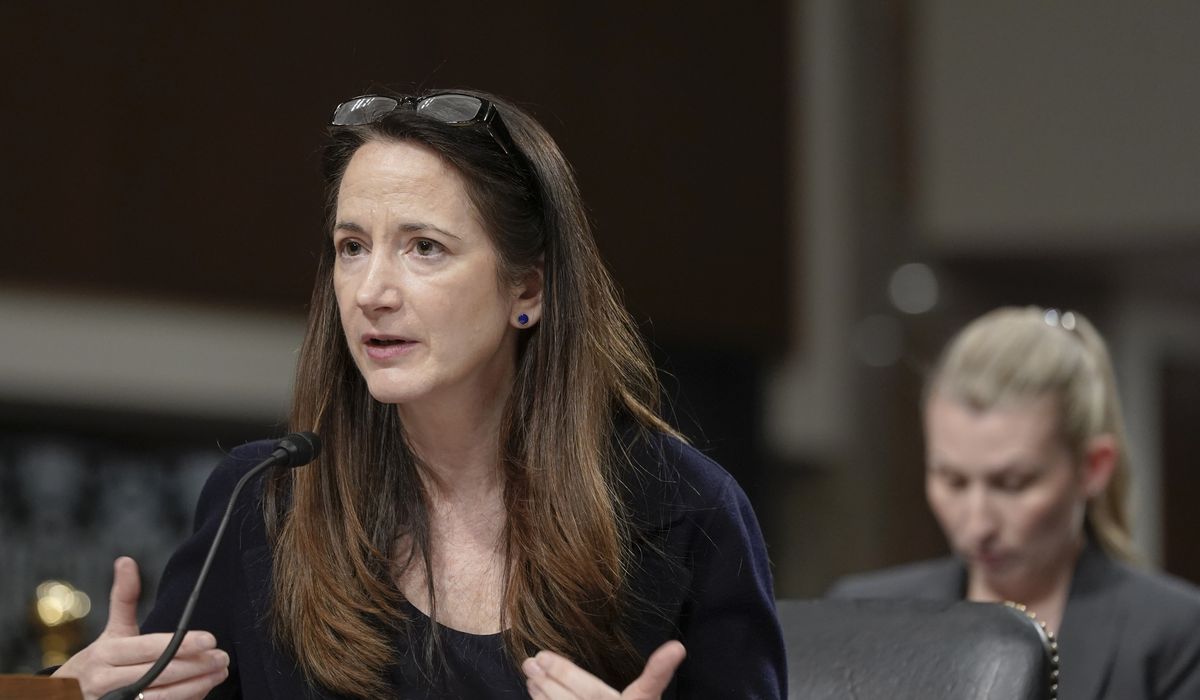


China’s significant economic problems are increasing the danger that Beijing will strike out against Taiwan or another regional adversary, the Biden administration’s director of national intelligence warned in a threat assessment made public Monday.
DNI Avril Haines told the Senate Select Committee on Intelligence that China’s communist leadership fears a U.S. nuclear “first strike.” In response, it has deployed more than 300 ground-based nuclear intercontinental ballistic missiles in western China. The expanding nuclear forces increase the danger that Beijing will feel emboldened to launch conventional conflicts, she said.
“Taiwan is a significant potential flashpoint for confrontation between the PRC and the United States, as Beijing claims that the United States is using Taiwan to undermine China’s rise,” Ms. Haines said in prepared remarks, referring to the People’s Republic of China.
“Beijing will use even stronger measures to push back against perceived increases in U.S. support to Taiwan.”
Ms. Haines’ testimony during the annual threat hearing was disrupted temporarily by a pro-Hamas demonstrator’s shouting during the hearing. A second protester calling for an Israeli cease-fire also disrupted the proceedings. Both were quickly escorted out of the hearing.
In addition to China, Russia continues to pose threats to American security and conflicts in Ukraine and the Middle East highlight the increasing transnational dangers, the panel of security chiefs told lawmakers. The panel included FBI Director Christopher A. Wray; CIA Director William J. Burns; Air Force Gen. Timothy D. Haugh, director of the National Security Agency; and Air Force Lt. Gen. Jeffrey A. Kruse, director of the Defense Intelligence Agency.
Ms. Haines said Chinese President Xi Jinping, who is presiding in Beijing over the closing sessions of a major national congress this week, is driving the country to become the dominant world power.
Deep-seated economic crises, endemic corruption and demographic decline are serious problems for China’s leadership.
“China’s serious demographic and economic challenges may make it an even more aggressive and unpredictable global actor,” Ms. Haines said, and Beijing is facing “myriad domestic challenges.”
Ms. Haines testified that China’s military lacks recent warfighting experience, which weakens the effectiveness of the People’s Liberation Army and probably will lead Mr. Xi and other Chinese leaders to avoid launching a war for now.
“In addition, PRC leaders almost certainly are concerned about the ongoing impact of corruption on the military’s capabilities and reliability, judging from a purge of high-level officers, including the defense minister, in 2023,” she said.
Still, Chinese military capabilities, bolstered by advanced arms technology, continue to expand with the deployment of multiple types of missiles, including hypersonic missiles, aircraft carriers and new warplanes.
Space and cyberspace weaponry developed by the Chinese military also pose threats, she said.
“If Beijing believed that a major conflict with the United States were imminent, it would consider aggressive cyberoperations against U.S. critical infrastructure and military assets,” Ms. Haines said. “Such a strike would be designed to deter U.S. military action by impeding U.S. decision-making, inducing societal panic and interfering with the deployment of U.S. forces.”
Ms. Haines said Russia’s war in Ukraine has caused “enormous damage” inside the country and abroad. Moscow has strengthened ties with China, Iran and North Korea to bolster defense production and its economy.
Russia is seeking to avoid a conflict with the United States and the NATO alliance but is continuing to conduct asymmetric activity globally below the threshold of direct military conflict, she said.
Despite its estimated 300,000 casualties in Ukraine, Russia has gained strategic military advantages in recent months and is “increasingly shifting the momentum in Moscow’s favor,” Ms. Haines said.
On Iran, Ms. Haines said U.S. officials assess that Tehran is not engaged in developing key nuclear arms but, since 2020, has “greatly expanded its nuclear program” should it ever need to obtain a bomb and is no longer constrained by the 2015 nuclear agreement with the West.
Iran is taking action “that better positions it to produce a nuclear device if it chooses to do so,” she said.
The North Korean threat also is increasing. The military under North Korean leader Kim Jong-un has built up its nuclear arsenal to offset the weaknesses of its conventional military forces.
Mr. Kim “remains strongly committed to developing capabilities intended to challenge regional missile defense, diversify options to deliver nuclear warheads, and enhance second-strike capabilities,” Ms. Haines said.
In 2023, North Korea revealed unmanned aerial vehicles similar to the MQ-9 Predator and Global Hawk drones. The regime in Pyongyang is also building more capable missiles, including cruise missiles, ICBMs and hypersonic glide vehicles.
In January, North Korea launched a solid-fueled intermediate-range ballistic missile armed with a maneuverable, hypersonic reentry vehicle, she said.
• Bill Gertz can be reached at bgertz@washingtontimes.com.
